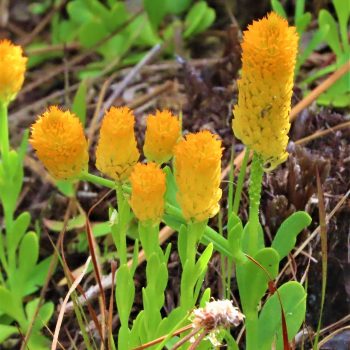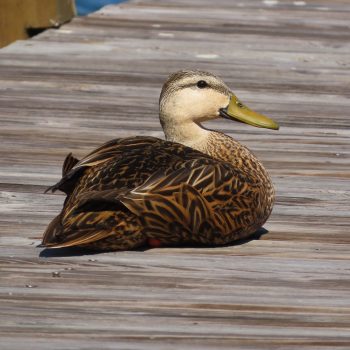
- A S carpenter bee foraging on seaside goldenrod planted in my yard
- Drumheads blooming at the Gordon Smith Trail
- A twin flower blooming at the Gordon Smith Trail
- Yellow/orange bachelor’s buttons at the Gordon Smith Trail
- A grass pink orchid at the Gordon Smith Trail
- A meadow beauty at the Gordon Smith Trail
- A moon rise over our Lemon Bay dock reveals a yellow crowned night heron foraging
- A mottled duck on our dock is surprisingly beautiful
- A “muddled duck” is a hybrid of the native mottled and a mallard not normally found here
- A catbird enjoys a bath in our yard
- A palm warbler searches for nectar in a bird of paradise flower
- A prairie warbler bathes in one of our yard drip baths
- A cedar waxwing tries to eat a large strangler fig fruit in our yard
- A great egret catches a non-native but very edible anole in our yard
- A screech owl moves into a new box replacing one destroyed by a hurricane in our yard
- An eastern rat snake in FL looks very different than the same species up north which is black
In middle to late March weather conditions in SW FL are becoming very dry. There is very little rain (April is the driest month) and the temperatures are rising into the 80’s regularly during the daytime. This causes obvious desiccation stress to plants and animals under natural conditions. There are also the “unnatural” conditions due to the common practice of burning the woods during the dry season. Natural fires would have primarily occurred historically during the wet season, sparked by lightning strikes. The ecological damage done by these dry season fires is considerable but they do have one interesting benefit, the stimulation of flowering by herbaceous plants in pine flatwoods.
In my Manasota Key yard which is not irrigated we have relatively few native plants that bloom during this dry season of year. I have planted some seaside goldenrods and watch them for visits by insect pollinators. Here is one example of a spectacular southern carpenter bee which does not fortunately bore into house timbers as some northern species do.
In contrast when I visited the Gordon Smith Trail (in Myakka State Forest) on March 26, 2023, the area had obviously been burned several months previously and flowers were blooming in profusion. Now the woodland itself was in poor shape due to loss of trees of all ages due to hot fires started at the wrong time of year and tree blow downs due to the hurricane of Sept. 28, 2022, but the results in blooming of wildflowers were spectacular. Just to give a few examples, look at these pictures of drumheads (very common this year in contrast to most years), twinflower, yellow bachelor’s buttons (actually orange), the amazing grass pink- an orchid, and the meadow beauty. The variation in color and form of these very different species is remarkable but of course many are low growing and dispersed in the undergrowth. But viewed up close they are as beautiful as anything you will see in the most pampered garden.
Now despite the lack of such flowering in our yard, there is a striking pattern to animal life in the dry season. We are adjacent to Lemon Bay for species that inhabit salt water and provide fresh water baths with drips for other forms. During a moon rise in our backyard on March 7 you can just see a yellow crowned night heron in the foreground foraging along the shore for crabs most likely. A mottled duck came out of the bay and was resting on the dock- notice the beautiful plumage. This is a wild type mottled duck not the “muddled ducks” you will see in more developed areas such as Arlington Park in Sarasota where ducks seem to be a cross between non-native mallards and mottled ducks.
In our yard, birds enjoy a daily or even more often trip to the bird bath. There are numerous catbirds in our yard spending the winter before migrating back to the north to breed; it is a peculiar fact that they do not breed here. We have four backyard warblers here commonly during the winter, yellow rumps, palms, prairies and yellow throated. A palm warbler is shown here looking for nectar in the flowers of a non-native bird of paradise plant. A prairie is seen engaging in a vigorous bath. Only some prairies may remain here to breed in the mangroves. The rumps and the palms will migrate far to the north, many even into Canada. Our two huge strangler fig trees have had plenty of fruit this winter which has been well enjoyed by the cedar waxwings- this bird is dealing with a fruit larger than its mouth! One result of all this fruit consumption is a lot of dirty cars underneath the trees.
A common sight in yards are great egrets foraging for terrestrial prey, especially the non-native Cuban anole. This bird has caught a juicy lizard prize and is benefitting both from the profusion of these anoles and its ability to utilize human developed habitats. The white ibis have similarly become proficient in catching prey in lawns and will continue to do better than species which are more wary of human dominated habitats. Another bird that has adapted well to the human landscape is the screech owl. We have had owls nesting in boxes we put up for decades and a bird is now occupying a new box that had to be replaced after the hurricane knocked over the tree.
Reptiles are doing well in our yard during the dry season as is seen particularly by the large numbers of anoles (including a few native green anoles), skinks, box turtles, occasional gopher tortoises, black racers, corn snakes and chicken snakes. I recently came across a chicken or eastern rat snake crawling out from under a shed and admired its orange color in the sun. Surprisingly these snakes, colored so differently from the common black rat snakes up north, are considered to be the same species, Pantherophis alleghaniensis.
So during the winter dry season enjoy the seasonal changes in flowers and animal activity related to rain or lack thereof, and fire (even if timed in an unnatural fashion in winter instead of during the time of summer lightning strikes). Indeed keep track of the local burns and check on the occurrence of flowering within the several months after a fire. You may be rewarded by encountering an astounding amount of flowering. It would seem that this timing of flowering to occur just after fires would be a similar process by which ephemeral spring flowering up north occurs on ground level just before leaves emerge on trees. These plants need a certain amount of sunlight to grow and either fire or seasonal loss of leaves will accomplish this.
















